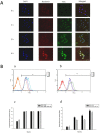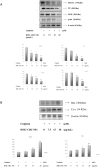Demethoxycurcumin-Loaded Chitosan Nanoparticle Downregulates DNA Repair Pathway to Improve Cisplatin-Induced Apoptosis in Non-Small Cell Lung Cancer
- PMID: 30563166
- PMCID: PMC6320861
- DOI: 10.3390/molecules23123217
Demethoxycurcumin-Loaded Chitosan Nanoparticle Downregulates DNA Repair Pathway to Improve Cisplatin-Induced Apoptosis in Non-Small Cell Lung Cancer
Abstract
Demethoxycurcumin (DMC), through a self-assembled amphiphilic carbomethyl-hexanoyl chitosan (CHC) nanomatrix has been successfully developed and used as a therapeutic approach to inhibit cisplatin-induced drug resistance by suppressing excision repair cross-complementary 1 (ERCC1) in non-small cell lung carcinoma cells (NSCLC). Previously, DMC significantly inhibited on-target cisplatin resistance protein, ERCC1, via PI3K-Akt-snail pathways in NSCLC. However, low water solubility and bioavailability of DMC causes systemic elimination and prevents its clinical application. To increase its bioavailability and targeting capacity toward cancer cells, a DMC-polyvinylpyrrolidone core phase was prepared, followed by encapsulating in a CHC shell to form a DMC-loaded core-shell hydrogel nanoparticles (DMC-CHC NPs). We aimed to understand whether DMC-CHC NPs efficiently potentiate cisplatin-induced apoptosis through downregulation of ERCC1 in NSCLC. DMC-CHC NPs displayed good cellular uptake efficiency. Dissolved in water, DMC-CHC NPs showed comparable cytotoxic potency with free DMC (dissolved in DMSO). A sulforhodamine B (SRB) assay indicated that DMC-CHC NPs significantly increased cisplatin-induced cytotoxicity by highly efficient intracellular delivery of the encapsulated DMC. A combination of DMC-CHC NPs and cisplatin significantly inhibited on-target cisplatin resistance protein, ERCC1, via the PI3K-Akt pathway. Also, this combination treatment markedly increased the post-target cisplatin resistance pathway including bax, and cytochrome c expressions. Thymidine phosphorylase (TP), a main role of the pyrimidine salvage pathway, was also highly inhibited by the combination treatment. The results suggested that enhancement of the cytotoxicity to cisplatin via administration of DMC-CHC NPs was mediated by down-regulation of the expression of TP, and ERCC1, regulated via the PI3K-Akt pathway.
Keywords: ERCC1; NSCLC; chitosan; demethoxycurcumin.
Conflict of interest statement
The authors declare no competing financial interest.
Figures




Similar articles
-
Demethoxycurcumin sensitizes the response of non-small cell lung cancer to cisplatin through downregulation of TP and ERCC1-related pathways.Phytomedicine. 2019 Feb;53:28-36. doi: 10.1016/j.phymed.2018.08.005. Epub 2018 Aug 17. Phytomedicine. 2019. PMID: 30668408
-
Dual drug-loaded biofunctionalized amphiphilic chitosan nanoparticles: Enhanced synergy between cisplatin and demethoxycurcumin against multidrug-resistant stem-like lung cancer cells.Eur J Pharm Biopharm. 2016 Dec;109:165-173. doi: 10.1016/j.ejpb.2016.10.014. Epub 2016 Oct 25. Eur J Pharm Biopharm. 2016. PMID: 27793756
-
Forming of demethoxycurcumin nanocrystallite-chitosan nanocarrier for controlled low dose cellular release for inhibition of the migration of vascular smooth muscle cells.Mol Pharm. 2012 Aug 6;9(8):2268-79. doi: 10.1021/mp300150q. Epub 2012 Jul 13. Mol Pharm. 2012. PMID: 22788791
-
Excision repair cross-complementation group 1 (ERCC1) in platinum-based treatment of non-small cell lung cancer with special emphasis on carboplatin: a review of current literature.Lung Cancer. 2009 May;64(2):131-9. doi: 10.1016/j.lungcan.2008.08.006. Epub 2008 Sep 19. Lung Cancer. 2009. PMID: 18804893 Review.
-
Influence of genetic markers on survival in non-small cell lung cancer.Drugs Today (Barc). 2003 Oct;39(10):775-86. doi: 10.1358/dot.2003.39.10.799471. Drugs Today (Barc). 2003. PMID: 14668933 Review.
Cited by
-
Curcuminoids Inhibit Angiogenic Behaviors of Human Umbilical Vein Endothelial Cells via Endoglin/Smad1 Signaling.Int J Mol Sci. 2022 Mar 31;23(7):3889. doi: 10.3390/ijms23073889. Int J Mol Sci. 2022. PMID: 35409247 Free PMC article.
-
Validation of a Quantification Method for Curcumin Derivatives and Their Hepatoprotective Effects on Nonalcoholic Fatty Liver Disease.Curr Issues Mol Biol. 2022 Jan 15;44(1):409-432. doi: 10.3390/cimb44010029. Curr Issues Mol Biol. 2022. PMID: 35723408 Free PMC article.
-
Nanomedicine Strategies for Management of Drug Resistance in Lung Cancer.Int J Mol Sci. 2022 Feb 6;23(3):1853. doi: 10.3390/ijms23031853. Int J Mol Sci. 2022. PMID: 35163777 Free PMC article. Review.
-
Curcuminoids as Cell Signaling Pathway Modulators: A Potential Strategy for Cancer Prevention.Curr Med Chem. 2024;31(21):3093-3117. doi: 10.2174/0929867331666230809100335. Curr Med Chem. 2024. PMID: 37559247 Review.
-
Synthesis of Curcumin Derivatives and Analysis of Their Antitumor Effects in Triple Negative Breast Cancer (TNBC) Cell Lines.Pharmaceuticals (Basel). 2019 Oct 26;12(4):161. doi: 10.3390/ph12040161. Pharmaceuticals (Basel). 2019. PMID: 31717764 Free PMC article.
References
MeSH terms
Substances
LinkOut - more resources
Full Text Sources
Medical
Research Materials

